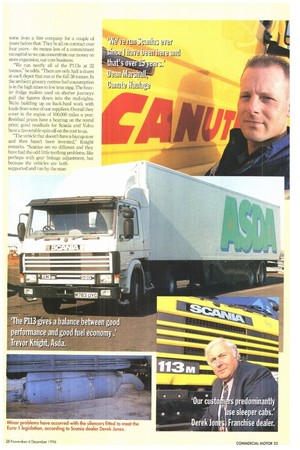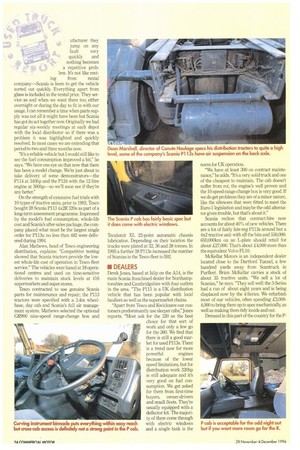can also be equipped with air suspension on the front
Page 136

Page 137

Page 138

Page 139

If you've noticed an error in this article please click here to report it so we can fix it.
axle. Before Scania pur sued the fleet market the larger R cab was the most popular unit. However, over recent months it has been overtaken in popularity by the P cab. They're the same width but the P model is less luxurious and, being mounted lower on the chassis, is not so roomy so it's usually specified as a single sleeper or short day cab. It's commonly used on nine and 11-litre models where its low entry makes it ideal for distribution work.
• EVOLUTION
The P113 was a natural progression from the 112; it appeared with a face lifted cab in March 1988. The only wheelbase available was 3.4m until October 1992 when a 3.8m option was added. To operate legally with a maximumlength 13.6m semi-trailer the longer of the two tractor chassis is needed. The 11-litre engine dates back to the late sixties but was uprated from 280 to 306hp with a turbocharger for the 3-Series. In 1991 a reworked unit with a smaller turbo, better breathing and charge cooling produced 310hp; 320 and 360hp charge-cooled versions were added to the range at about the same time. The turbocompound 11-litre engine developing high torque and 400hp was also launched in 1991. Scania showed it around in the UK in left-hand drive and it performed pretty well as a long-haul tractor. But for shorter domestic journeys any slight advantage it might have over the 380 EDC unit (launched in October 1992) did not justify the extra cost. Euro-2 brought the demise of the P113. Now the same range of power is offered by the nine-litre P94 at 310hp; the 11-litre at 340hp; and the 12-litre P124 at 360 and 400hp.
Canute Haulage is a specialist distribution company based in Aveley Essex with a fleet of more than 200 vehicles. Most of the company's fleet operates in the customers' livery. As well as a mixture of Volvos, Dafs and MercedesBenzes, Canute runs some 140 Scanias.
"We've run Scanias ever since I have been here and that's over 15 years," says director Dean Marshall. "We've got about 60 P113 tractive units, all under five years old. We run both 320s and 360s and depending on the type of work they're on we specify such things as a radio/ cassette, electric windows and double tanks. They're so reliable that we're thinking of keeping them longer; perhaps up to eight years. We have R-cab models as well but the Path is big enough. The trim is a bit basic: nothing much has changed over the past five years but it stands up to the work.
"Overall the level of specification is high," he adds. "A number of them are equipped with air suspension. We've downplated some of our 320s for operation .at 31 tonnes. They cover about 120,000km a year and there isn't much difference in fuel consumption between the two models. Both return between 7.5 and 8mpg. There's nothing you could say is a regular fault, apart from the gear lever balljoints they tend to break off. Everything else, including the driveline and electrics, are pretty reliable. We cover about 120,000km a year and get between 18 months and two years out of the brakes. The only thing I don't like about them is the rear lights: they're just too big."
Trevor Knight is fleet engineering manager for the Asda food chain, based in Leeds. From eleven depots around the country he operates more than 500 tractive units. "They're not all Scanias though," he says. "We also run about 200 Volvos but all of our Scanias are P113.320s. We went for the P113 because it gives a balance between good performance for the driver and good fuel economy for the company. We have been with Scania Hire Management for about two years but we had some from a hire company for a couple of years before that. They're all on contract over four years--its means less of a commitment on capital so we can concentrate our money on store expansion, our core business.
"We run nearly all of the P113s at 32 tonnes," he adds. "There are only half a dozen at each depot that run at the full 38 tonnes. in the ambient grocery centres fuel consumption is in the high nines to low tens mpg. The heavier fridge trailers used on shorter journeys pull the figures down into the mid-eights. We're building up on back-haul work with loads from some of our suppliers. Overall they cover in the region of 100,000 miles a year. Residual prices have a bearing on the rental price; good residuals for Scania and Volvo have a favourable spin-off on the cost to us.
"The vehicle that doesn't have a hiccup now and then hasn't been invented," Knight remarks. "Scanias are no different and they have had the odd little teething problems, like perhaps with gear linkage adjustment, but because the vehicles are both supported and run by the man ufacturer they • jump on any
aka fault very
quickly and nothing becomes a repetitive problem. It's not like rent ing from rental company—Scania is keen to get the vehicle sorted out quickly. Everything apart from glass is included in the rental price. They service as and when we want them too; either overnight or during the day to fit in with our usage. I can remember a time when parts supply was not all it might have been but Scania has got its act together now. Originally we had regular six-weekly meetings at each depot with the local distributor so if there was a problem it was highlighted and quickly resolved. In most cases we are extending that period to two and three months now.
"It's a reliable vehicle but I would still like to see the fuel consumption improved a bit," he says. "We have one eye on that now that there has been a model change. We're just about to take delivery of some demonstrators—the P114 at 340hp and the PI24 with the 12-litre engine at 360hp—so we'll soon see if they're any better."
On the strength of extensive fuel trials with 10 types of tractive units, prior to 1992, Tesco bought 28 Scania P113 4x2R 320s as part of a long-term assessment programme. Impressed by the model's fuel consumption, whole-life cost and Scania's after-sales package, the company placed what must be the largest single order for P113s: no less than 482 were delivered during 1994.
Alan Mathews, head of Tesco engineering distribution, explains: "Competitive testing showed that Scania tractors provide the lowest whole-life cost of operation in Tesco fleet service." The vehicles were based at 18 operational centres and used on time-sensitive deliveries to maintain stock levels at 416 supermarkets and super-stores.
Tesco contacted to use genuine Scania parts for maintenance and repair; the P113 tractors were specified with a 3.4m wheelbase, day cab and Scania's full air management system. Mathews selected the optional GR900 nine-speed range-change box and Tecalernit XL 22-point automatic chassis lubrication. Depending on their location the trucks were plated at 32, 36 and 38 tonnes. In 1995 a further 28 P113s increased the number of Scanias in the Tesco fleet to 592.
Derek Jones, based at Islip on the A14, is the main Scania franchised dealer for Northamptonshire and Cambridgshire with four outlets in the area. "The P113 is a UK distribution vehicle that has been popular with local hauliers as well as the supermarket chains.
"Apart from Tesco and Kwicksave our customers predominantly use sleeper cabs," Jones reports. "Most ask for the 320 as the best choice for that sort of work and only a few go for the 360. We find that there is still a good market for used P113s. There is a trend now for more
powerful engines because of the lower speed limitations, but for distribution work 320hp is still adequate and it's very good on fuel consumption. We get asked for them from first-time buyers, owner-drivers and small fleets. They're usually equipped with a deflector kit. The majority of them come through with electric windows and a single tank is the
"We have at least 300 on contract maintenance," he adds. it's a very solid truck and one of the cheapest to maintain. The cab doesn't suffer from rot, the engine's well proven and the 10-speed range-change box is very good. If we do get problems they are of a minor nature, like the silencers that were fitted to meet the Euro-1 legislation and maybe the odd alternator gives trouble, but that's about it."
Scania reckon that contract-hire now accounts for about 40% of new vehicles. There are a lot of fairly late-reg P113s around but a 4x2 tractive unit with all the bits and 550,000650,000km on an L-plate should retail for about £27,000. That's about £4,000 more than the equivalent Volvo FLIO.
McKellar Motors is an independent dealer located close to the Dartford Tunnel, a few hundred yards away from Scantruck in Purfleet Brian McKellar carries a stock of about 35 tractive units. "We sell a lot of Scanias," he says. "They sell well: the 3-Series had a run of about eight years and is being displaced now by the 4-Series. We refurbish most of our vehicles, often spending £3,0004,000 to bring them up to spec mechanically, as well as making them tidy inside and out Demand in this part of the country for the P cab is very small," he adds. 'We're in a heavy haulage area and we get a lot of continental users. We serve UK-based companies as well but in the main my customers are looking for 350hp-plus now. There's always the exception, but if a driver sleeps out for three nights a week he wouldn't suffer a P-cab for very long; he wants something bigger. Apart from that owner-drivers are image conscious so we don't sell them many P.cabs. There are always a few on the market but they're not very desirable secondhand. Al auction an L reg 4x2 P113 on air would probable fetch about L23,000."
Back in August 1990 when we tested Scania's P113 320 tractive unit it cost just over £2,000 more than the Mercedes-Benz 1733, but with the price of fuel today that sort of price difference might soon be recovered.
The P-cab is not normally first choice for the owner-driver but it's quite acceptable for the small fleet operator. New P1 13s were bought in large numbers by the big distribution fleets, often on contract hire, so even quite late models are readily available although 360hp variants are harder to find.
The cab is fairly basic but the specification often includes electric windows and a roof deflector kit. Residual prices hold up quite well and any faults tend to be of a minor nature as the cab and the driveline are all well proven. Scania has added 25 dealers to its network over the past two years to improve customer service, Is the P113 a good buy? If you can live with a small sleeper, the answer is yes. 11 by Bill Brock




















































































































































































































